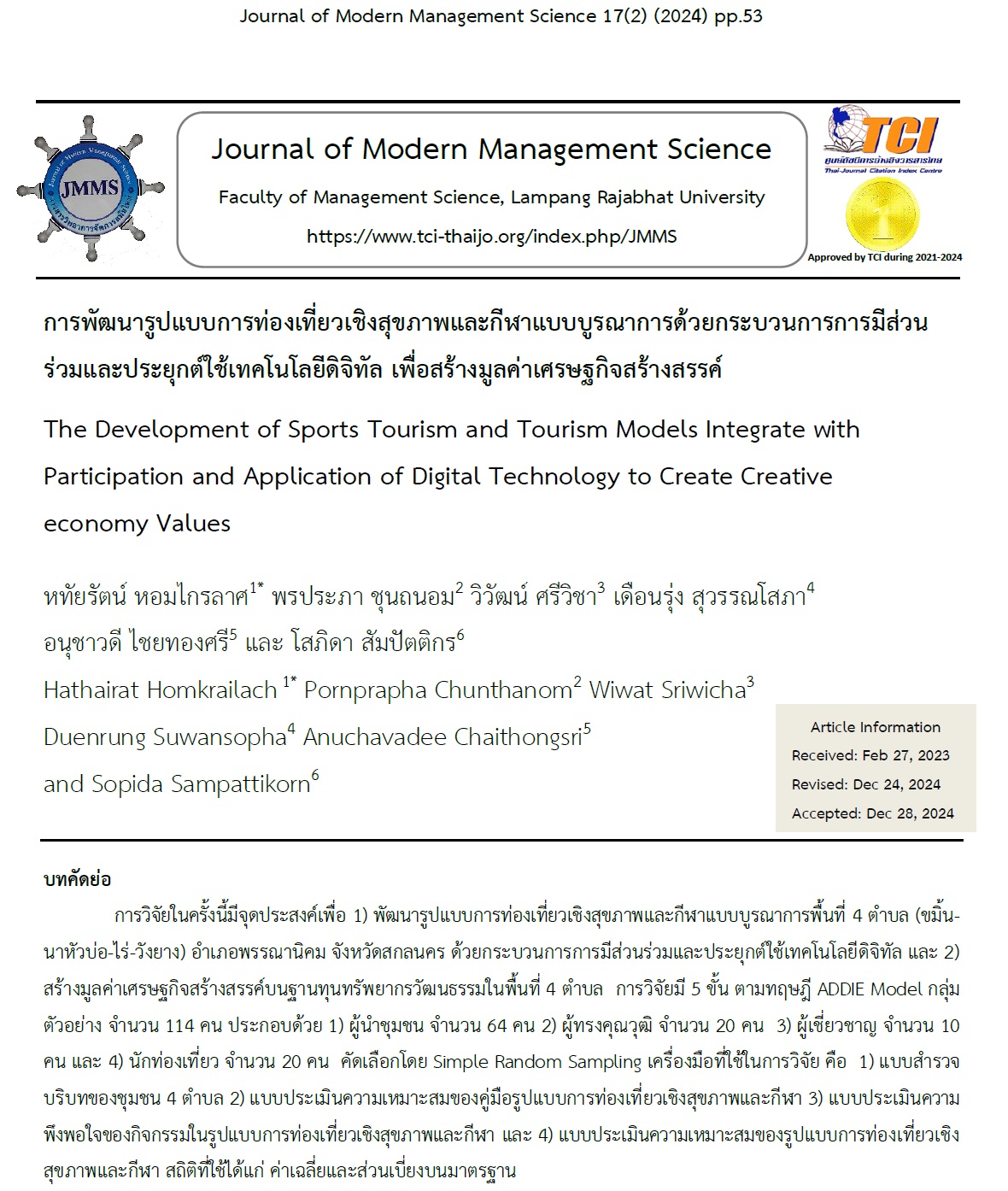The Development of Sports Tourism and Tourism Models Integrate with Participation and Application of Digital Technology to Create Creative economy Values
Main Article Content
Abstract
The objectives of this research are: 1) to develop an integrated health and sports tourism model for four sub-districts (Khamin, Na Hua Bo, Rai, and Wang Yang) in Phanna Nikhom District, Sakon Nakhon Province, using participatory processes and the application of digital technology; and 2) to create creative economic value based on cultural resource capital in the area. The research follows five stages as per the ADDIE Model. Total sample size of 114 people, including 1) 64 village heads, 2) 20 qualified experts, 3) 10 specialists, and 4) 20 tourists, selected using purposive sampling. The research tools include: 1) a community context survey for the four sub-districts, 2) an evaluation form for the suitability of the health and sports tourism model guide, 3) an activity satisfaction evaluation form, and 4) a suitability assessment form for the tourism model. Statistical tools used are mean and standard deviation.
The results revealed that the integrated health and sports tourism model for the four sub-districts in Phanna Nikhom District, Sakon Nakhon Province, developed through participatory processes and the application of digital technology, includes the following stages. Stage 1, community context study: natural resources identified include the Phu Phan mountain range, tourist attractions like Huai Sai-Khamin Reservoir, Phra That Phu Pek, Wat Tham Kham Temple, signature products such as indigo-dyed fabrics, the “Hit Sip Song Khong Sip Si” cultural traditions, local ethnic groups (Phu Tai, Lao), homestay accommodations, and seasonal local foods with unique identities such as the Phu Tai language and traditional clothing. Stage 2, the component Analysis of the integrated health and sports tourism model: the model comprises six components: 1) Infrastructure 2) Souvenir and gift products 3) Good hosts and local food 4) Tourism routes across four sub-districts 5) Tourism activities and 6) Media and storytelling. This model is collectively referred to as the IP2TS Model. Stage 3, the development of the tourism model guide: experts rated the suitability of the guide for the integrated health and sports tourism model developed through participatory processes and digital technology application at a high level ( = 4.15, S.D. = 0.67). Stage 4, trial implementation of the tourism model: tourists expressed high satisfaction with activities based on the integrated health and sports tourism model ( = 4.60, S.D. = 0.48). Stage 5, the evaluation of the tourism model: the overall suitability of the model was rated at a high level ( = 4.76, S.D. = 0.44).
Article Details

This work is licensed under a Creative Commons Attribution-NonCommercial-NoDerivatives 4.0 International License.
The article must be considered and accepted for publication by the editorial board of the Faculty of Management Science, Lampang Rajabhat University. The articles have been reviewed by a peer (peer review) and the author must update according to the suggestion if available before publication. Articles that are not considered the editorial team will inform the results of the consideration but will not send the original to the author.
JMMS is the Faculty of Management Science journal, Lampang Rajabhat University. Jmms published both print and online editions. We allow the use of articles for academic use under the scope of copyright law.
References
กัลยาณี กุลชัย (2560) .การสร้างคู่มือการท่องเที่ยวชุมชน โดยกระบวนการมีส่วนร่วมของชุมชน ตำบล บางน้ำผึ้งอำเภอพระประแดง จังหวัดสมุทรปราการ. วารสารสังคมศาสตร์ มหาวิทยาลัยศรีนครินทรวิโรฒ, 20, 26-41.
เขมลักษณ์ คุปคีตพันธ์ และปริญญา บรรจงมณี (2563).แนวทางการพัฒนาองค์ประกอบการท่องเที่ยวเชิงสุขภาพของนักท่องเที่ยวชาวยุโรปในจังหวัดประจวบคีรีขันธ์. วารสารบัณฑิตศึกษา, 14(1), 1-13.
ดุสิตพร ฮกทา,จุติมา บุญมีและ ธนินทร์ สังขดวง (2562) .การประเมินศักยภาพและออกแบบโครงข่ายการท่องเที่ยวเพื่อพัฒนาเศรษฐกิจฐานรากในตำบลนาหมื่นศรี อำเภอนาโยง จังหวัดตรัง. รายงานการวิจัย สืบค้นเมื่อ 12 กุมภาพันธ์ 2565 เข้าถึงจาก https://www.repository.rmutsv.ac.th
นาตยา เกตุสมบูรณ์และวันทนา เนาว์วัน (2562) .ศักยภาพด้านการท่องเที่ยวเพื่อการพัฒนาหมู่บ้านท่องเที่ยวหมู่บ้านหนองสรวง ตำบลกระแซง อำเภอบางไทร จังหวัดพระนครศรีอยุธยา. สมาคมสถาบันอุดมศึกษาเอกชนแห่งประเทศไทยในพระราชูปถัมภ์ สมเด็จพระเทพรัตนราชสุดาฯสยามบรมราชกุมารี, 25(1), 81-93.
แพรภัทร ยอดแก้ว (2565).แนวคิดเศรษฐกิจสร้างสรรค์กับการพัฒนาผลิตภัณฑ์เชิงสร้างสรรค์ของกลุ่มชาติพันธุ์ลาวครั่งในจังหวัดนครปฐม.การประชุมวิชาการระดับชาติ ครั้งที่ 14 มหาวิทยาลัยราชภัฏนครปฐม,หน้า 2873 – 2886,
วรปภา อารีราษฎร์, ธรัช อารีราษฎร์ และศิคริษฐ์ คุณชมภู. (2562). รูปแบบการประยุกต์เทคโนโลยีดิจิทัลสร้างสรรค์ตามแนวทางการจัดการท่องเที่ยว 7s เพื่อส่งเสริมการท่องเที่ยวเชิงวัฒนธรรมแบบมีส่วนร่วม.วารสารวิชาการการจัดการเทคโนโลยีสารสนเทศและนวัตกรรม , 6(1), 137-146.
สถาบันทรัพย์สินทางปัญญาแห่งจุฬาลงกรณ์มหาวิทยาลัย (2560).รายงานการวิเคราะห์แนวโน้มเทคโนโลยีและอุตสาหกรรมอุตสาหกรรมการท่องเที่ยวกลุ่มรายได้ดี และท่องเที่ยวเชิงสุขภาพ.โครงการพัฒนาผู้ประกอบการด้านทรัพย์สินทางปัญญาและนวัตกรรม,สืบค้นเมื่อ 19 ธันวาคม 2567 เข้าถึงจาก https://www.ipthailand.go.th/images/3534/web_ 01052018/Report_CHU/8_Well-being_06.12.2017_CHU.pdf


